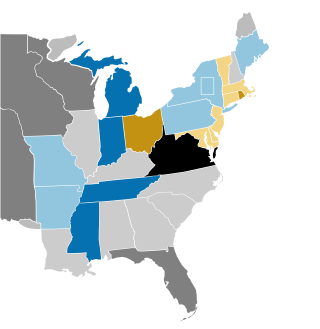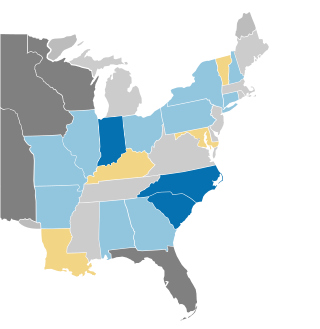
The 28th United States Congress was a meeting of the legislative branch of the United States federal government, consisting of the United States Senate and the United States House of Representatives. It met in Washington, D.C., from March 4, 1843, to March 4, 1845, during the third and fourth years of John Tyler's presidency. The apportionment of seats in this House of Representatives was based on the 1840 United States census. The Senate had a Whig majority, and the House had a Democratic majority.

The Mayor of Wellington is the head of the municipal government of the City of Wellington. The mayor presides over the Wellington City Council. The mayor is directly elected using the Single Transferable Vote method of proportional representation. The current mayor is Tory Whanau, elected in October 2022 for a three-year-term.
The 1842–43 United States House of Representatives elections were held on various dates in various states between August 1, 1842 and November 8, 1843. Each state set its own date for its elections to the House of Representatives before the first session of the 28th United States Congress convened on December 4, 1843. The exception was Maryland, who held theirs so late that they ran into February 1844. These elections occurred during President John Tyler's term. The congressional reapportionment based on the 1840 United States census unusually decreased the number of House seats, from 242 down to 223.

The 1843 United States Senate election in New York was held on February 7, 1843, by the New York State Legislature to elect a U.S. Senator to represent the State of New York in the United States Senate.

The 1844–45 United States Senate elections were held on various dates in various states, coinciding with James K. Polk's election. As these U.S. Senate elections were prior to the ratification of the Seventeenth Amendment in 1913, senators were chosen by state legislatures. Senators were elected over a wide range of time throughout 1844 and 1845, and a seat may have been filled months late or remained vacant due to legislative deadlock. In these elections, terms were up for the senators in Class 1.

The 1842–43 United States Senate elections were held on various dates in various states. As these U.S. Senate elections were prior to the ratification of the Seventeenth Amendment in 1913, senators were chosen by state legislatures. Senators were elected over a wide range of time throughout 1842 and 1843, and a seat may have been filled months late or remained vacant due to legislative deadlock. In these elections, terms were up for the senators in Class 3.
On May 4, 1841, a special election was held in Pennsylvania's 13th congressional district to fill a vacancy caused by the death of William S. Ramsey (D) on October 17, 1840, shortly after his re-election, and before the 26th Congress had ended.

The 1843 United States Senate election in Pennsylvania was held on January 10, 1843. Future President of the United States James Buchanan was re-elected by the Pennsylvania General Assembly to the United States Senate.
This is a list of members of the New South Wales Legislative Council from 1843 to 1851. The 1843 Electoral Act prescribed 36 members, 24 to be elected, 6 appointed by virtue of their office and 6 nominated. The appointments and elections were for five year terms and thus occurred in 1843, and 1848. The Speaker was Alexander Macleay until 19 May 1846 and then Charles Nicholson. The parliament was dissolved on 30 June 1851 as a result of the 1851 Electoral Act which increased the number of members in the Council to 54.
Elections to Liverpool Town Council were held on Wednesday 1 November 1843. One third of the council seats were up for election, the term of office of each councillor being three years.

In the Chicago mayoral election of 1845, Democratic nominee Augustus Garrett defeated Whig nominee John H. Kinzie and Liberty nominee Henry Smith by a 7.5% margin.
The 1843 New South Wales colonial election, the first in the colony, was held between 15 June and 3 July 1843, to elect 24 members from 18 electoral districts. Each district returned 1 member except for Port Phillip which returned 5 members while County of Cumberland, and Town of Sydney returned 2 each.
The 1848 New South Wales colonial election was held between 29 July and 2 August. No candidates were nominated for Port Phillip as a result of the campaign for independence from New South Wales, and a fresh writ was issued for an election on 3 October.

The 1843 Connecticut gubernatorial election was held on April 3, 1843. Incumbent governor and Democratic nominee Chauncey Fitch Cleveland was re-elected, defeating former state legislator, Amistad lawyer and Whig nominee Roger Sherman Baldwin with 50.13% of the vote.
The 1842 Massachusetts gubernatorial election consisted of an initial popular election held on November 14, 1842 that was followed by a legislative vote held on January 17, 1843. The ultimate task of electing the governor had been placed before the Massachusetts General Court because no candidate received the majority of the vote that was constitutionally required for a candidate to be elected through the popular election. Incumbent Whig Governor John Davis was defeated by Democratic nominee and former Governor Marcus Morton.
The 1843–44 Massachusetts gubernatorial election consisted of an initial popular election held on November 13, 1843, that was followed by a legislative vote held on January 8, 1844. The ultimate task of electing the governor had been placed before the Massachusetts General Court because no candidate received the majority of the vote that was constitutionally required for a candidate to be elected through the popular election. Incumbent Democratic Governor Marcus Morton was defeated by Whig Party nominee George N. Briggs.
The 1843 New South Wales colonial election was held between 15 June and 3 July 1843. This election was for 24 seats in the New South Wales Legislative Council and it was conducted in 15 single-member constituencies, two 2-member constituencies and one 5-member constituency, all with a first past the post system. This included 6 members in what became the Colony of Victoria and a single member for the coast north of Newcastle. The Legislative Council was a hybrid system with 36 members, 24 elected, 6 appointed by virtue of their office and 6 nominated. The appointments and elections were for five year terms.
The 1848 New South Wales colonial election was held between 29 July and 2 August 1848. This election was for 24 seats in the New South Wales Legislative Council and it was conducted in 15 single-member constituencies, two 2-member constituencies and one 5-member constituency, all with a first past the post system. The Legislative Council was a hybrid system with 36 members, 24 elected, 6 appointed by virtue of their office and 6 nominated. The appointments and elections were for five year terms.<

The 1843 Vermont gubernatorial election was held on September 5, 1843.